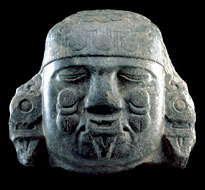|



Coyolxauhqui. Aztec, ca. 1500. Diorite, 80 x 85 x 68 cm. Museo Nacional de Antropología,
INAH, Mexico City. Photo Michel Zabé, assistant Enrique Macías.
Watch The Aztec Empire promotional spot which appears on Thirteen/WNET.
QuickTime version
Windows Media version
You can play the promotional spot through your browser provided the plug-ins are installed.
Download QuickTime
Download Windows Media
|
|



The Renaissance, an intellectual movement in the sciences and the arts of 15th-century Europe, had its counterpart in ancient Mexico, where two powerful indigenous states flourished, the Aztec empire, and its neighbor and traditional enemy, the Tarascan empire.
The Aztec Empire re-creates this period, bringing together a great number of art objects created by the various peoples who lived at this time, during the period that is known as the Late Postclassic.
The historic origins of the Aztec empire lie in a the military coalition known as the Triple Alliance. Three emerging states formed this union: the Mexica-Aztecs, whose capital city was Mexico-Tenochtitlan, renowned in its time; the Acolhua with Tetzcoco as their main city, considered the cultural center par excellence; and Tlacopan, which united the survivors of the ancient domain that once dominated the Valley of Mexico. The Aztecs shrewdly imposed their hierarchy on their allies and extended their dominion to the coasts of the Pacific Ocean and the Gulf of Mexico. They acquired power and riches based on a strict system of tributes, so that upon the arrival of the Spaniards in the early 16th century, their capital was considered the most significant and majestic city of its time.
The dominant language among the allies was Nahuatl, which became the lingua franca for most of Mesoamerica and was used to name the geographical features of ancient Mexico, even replacing the terms of other ancestral languages.
The other powerful indigenous state was the Tarascan empire, also known as Purepecha, whose main principal city was Tzintzuntzan. Toward the end of the Tarascan historical period, this city functioned as its political capital, from which the Tarascans dominated a broad area that included north-central and western Mexico. Their language was Porhe or Tarasco, fundamentally different from Nahuatl and not linked to any other language of ancient Mexico.
With the expansion of the Aztec empire an international artistic style flourished. This artistic language, even more than Nahuatl, enabled the various cultures of the empire to communicate with each other and share their stories and the knowledge of their deities and rituals.
Two extraordinary examples of the international style of the Aztec period are the sculptural images found in Coxcatlan of Coatlicue and Xiuhtecuhtli that constitute the introduction to the exhibition. As goddess of the earth, Coatlicue is the female expression of the creation and destruction of life. She is accompanied by Xiuhtecuhtli, the young god of fire, who as the essence of the masculine powers of light and heat also personifies the sun.
The exhibition is divided into twelve themes that provide a thorough representation of Aztec society from its development to the zenith of the empire and its decline.
[ MORE ]
Spanish overview RTF
or Spanish overview PDF
|